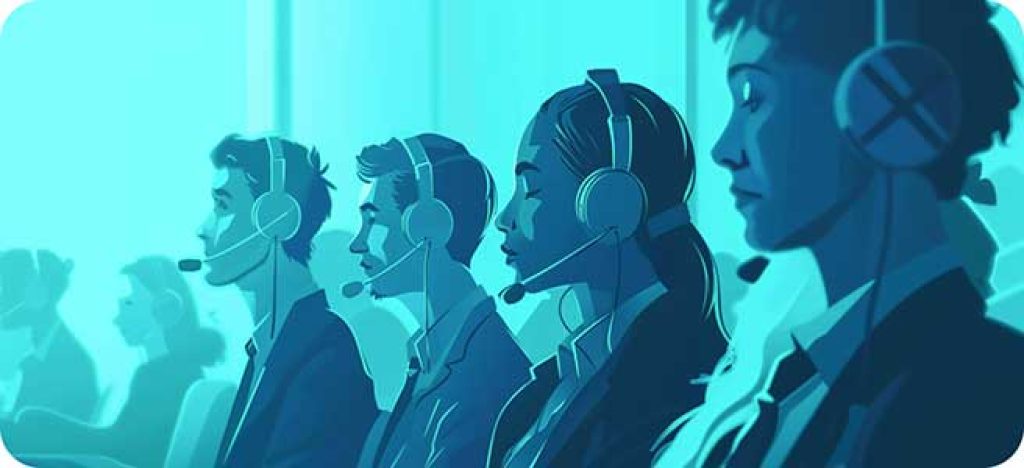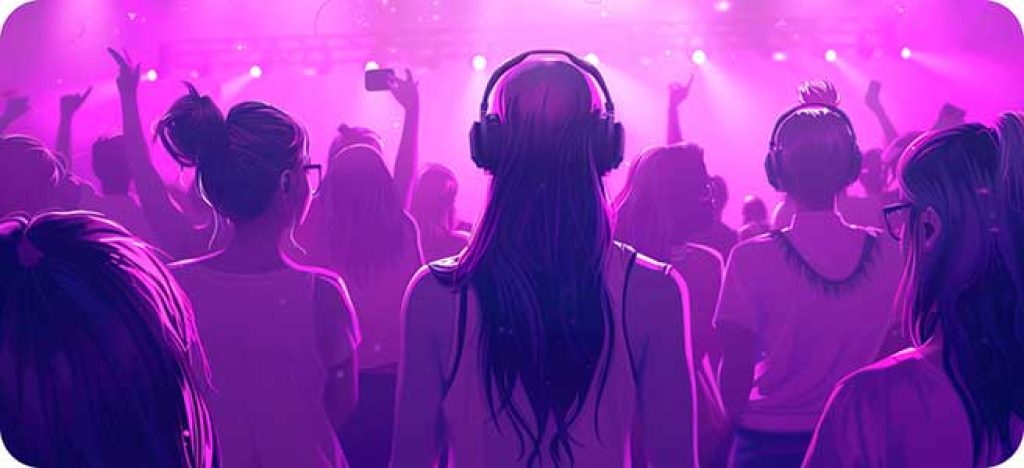Audio Description: Inclusive Access To Visual Media
Transmitting Key Visual Data For Blind & Visually Impaired Individuals Through The Use Of Audio Description Services
Audio description is a narrative technique that provides descriptive explanations of key visual elements in video content. This narration delivers information alternatively for people who are blind or who have low vision, describing things like actions, settings, scene changes, character appearances, and facial expressions. Audio description offers hearing-based access to important details in videos, movies, television shows, live performances, and other visual media, so people who are blind or who have visual impairments can enjoy the experience comparably, without vision.

How Does Audio Description Work?
Pre-recorded audio description is set as an additional track that runs in tandem with a movie or video’s main audio track. Because it is recorded before the movie or tv show is played, it offers more options for editing. When it’s available, pre-recorded audio can offer a lot of accurate detail that may not be available with a live description.
For live performances, business meetings, or as the updated equivalent of a sports announcer for events like a ball game, live descriptions can be presented in real-time. For this type of audio description, an experienced professional should be used, one who is familiar with the process of quickly observing, noting, and transmitting visual information as a verbal descriptive narration.
Why Is Audio Description Important For Equitable Access?
Offering audio descriptions for visual media is a fundamental part of providing equitable access and accessibility across various types of visual presentations:
- Entertainment
Movies, television shows, and online videos are a major source of entertainment for most people around the world. Without audio description, people who are blind or visually impaired miss out on crucial details that can affect their comprehension and enjoyment. Audio description opens up performances to everyone. - Social Media
Social media platforms rely heavily on images and videos to share information and experiences. Audio descriptions for social media content give people with visual impairments a different way they can stay connected and informed about current trends and pop culture references. It improves understanding of popular culture and digital interactions, enabling people with visual impairments to participate fully in digital conversations and communities. - Education
Educational materials for learners of all ages often include videos, slide-based or interactive presentations, and online lectures. Audio descriptions make these resources accessible for blind and visually impaired students, from early education on to college and university. - Business
Video conferencing has become commonplace in business. Audio descriptions for meetings, presentations, training session and demonstrations offer equitable access to important business interactions and information for employees who are blind or have low vision.

What Are Some Advantages Audio Description Offers?
The benefits of audio description extend beyond accessibility:
Accessibility & Enjoyment
Providing detailed descriptions of scenes and actions, audio description opens access to visual presentations and performances for those who are blind or visually impaired, allowing them to appreciate the full richness of the stories being shared visually.
Deeper Understanding
By describing visual cues like gestures and expressions, audio description offers a more complete understanding of visual content, even without sight. This supports blind users and those with low vision in imagining scenes and understanding subtleties in the narrative.
Literacy & Learning
Detailed descriptions of scenes, visual details, and actions support literacy and learning. Besides the access it can provide for blind individuals, audio description is also helpful for those with learning differences like dyslexia. It can clarify confusing visuals and zoom focus in on data, improving comprehension and information retention.
How Can Audio Description Help A Wider Audience?
The following examples illustrate some of the ways audio description services can offer access to all, including those who are blind or visually impaired:
Audio Description Use Cases
- Movies and Television
Streaming services increasingly offer audio description options. Karina, who has low vision, uses audio description to enjoy the latest blockbuster movies and a popular detective series at home on her favorite streaming platform. She can experience the thrill of cinematic storytelling just as her sighted friends do. - Live Performances and Events
Jamal, who is blind, attends a lot of live theater shows and classical music concerts. Audio description via a headset adds live commentary on the visual aspects of the performances. He enjoys these events alongside everyone else, without missing a single bit of the atmosphere. - Educational Content
Anika, a university student with an eye injury, uses audio description for her biology videos, enabling her to understand complex concepts that are often demonstrated visually.
Many educational institutions now incorporate audio descriptions into online courses and lectures. For Eric, who has a cognitive disability that disrupts visual processing, this offers equal access to learning materials. - Online Videos and Webinars
Platforms like YouTube and Zoom offer automated or manual audio description features for online videos and webinars, making them inclusive for a wider audience. Alex, who is visually impaired, often participates in online professional development webinars. With audio description, he can follow along with visual presentations and demonstrations. - Video Games
Taylor, who has low vision, enjoys video games designed with audio description, narrating on-screen action. Gaming has become a more inclusive hobby, as game designers and developers build in accessible options. - Art Exhibitions
Jordan, who is Deaf and who also has blurred vision, visits a museum where audio description devices are available directly to assistive listening devices, providing detailed descriptions of the artworks. Their appreciation for the visual arts does not require perfect vision, or perfect hearing. - Social Media Content
Some social media platforms are piloting features that automatically generate captions describing the content of images. This is a positive step towards greater accessibility, but human-narrated audio descriptions can provide richer detail. Riley and Avery, two content creators who want to support accessibility, take turns performing their TikTok dance routines and providing clear audio descriptions.

An Overview: Adding Audio Description To Visual Content
For content creators and administrators, adding audio description is one important way to provide accessible information based on visuals. However, it is not necessarily a simple process, and a professional should be hired if possible, certainly for live descriptions.
When audio description is recorded ahead of time, it is advisable for whoever will be writing up the audio description to watch the visual media more than once, taking notes of important elements that should be included. Then, a script can be written up, either in a formal script style, or as a series of brief bullet points for the audio narrator to follow for each scene. For the recording itself, the ideal option is a trained audio description narrator, or a skilled voice actor. However, if a professional narrator is not available or not in budget, look for a narrator who is a native speaker of the language being used, with a clear voice, neutral accent, and good description skills.
It is important to remember that the voice of the audio description narrator should never be louder than the audio in the performance or the visual media that’s being described, and the voice tone and volume of the narration should remain consistent. This is relevant for both pre-recorded and live audio description.
Once recorded, the description should be edited to remove extra sounds, such as background noise or “um” and “uh”. At this point, the audio description should be reviewed for any errors, and checked for clarity, tone, and accuracy before it is synced to the video. Then, the audio description should be synced very carefully to the performance or presentation it describes. As with so many things, in this case, timing is everything.
Audio Description and Accessibility Regulations
The Web Content Accessibility Guidelines (WCAG) are international recommendations for making web content accessible to people with disabilities. While not legally binding itself, WCAG serves as a key reference point for disability rights regulations around the world.
In the United States, the Americans with Disabilities Act (ADA) is a general law prohibiting discrimination based on disability. Section 508 of the Rehabilitation Act specifically mandates accessibility of electronic and information technology used by the US federal government. In Europe, the European Accessibility Act (EAA), also known as the Web Accessibility Directive (WAD), requires certain digital services to meet accessibility standards. The harmonized standard EN 301 549 provides technical specifications for achieving web accessibility. Other countries, as well as various member states within the EU, have their own local legislation, which is usually based on the WCAG as well.
Meeting WCAG standards, including providing audio description for pre-recorded video content as it is specifically explained in the WCAG success criteria, helps organizations comply with these and similar regulations.
Specifically for television and major cinematic productions, other accessibility laws may apply to visual media, such as the 21st Century Communications and Video Accessibility Act (CVAA) in the United States, which can require audio description to be provided for some types of broadcast programming. This is mandated and enforced by the FCC, the Federal Communications Commission. Whatever the standards and regulations in your country, it is a good idea to not only follow those laws, but to understand how laws in other countries may apply to your content, if it is shown there.
Audio Description, Then And Now
There are documented instances of live narration for visually impaired audiences in the late 1920s, the early days of cinema. Radio broadcasts with descriptions of films emerged in the 1940s and 1950s. Fast forward to the 1980s, and the development of closed captioning for television led to the exploration of audio description for this new medium.
Pioneering work in audio description was also happening in museums around this time. The concept of using audio cassettes with narrated descriptions for exhibits began to be put into practice, allowing visitors with visual impairments to experience these cultural spaces in a richer way. Today, audio description has become an established cornerstone of accessibility in museums, often delivered through mobile apps or dedicated devices. As with all technologies, only an ongoing evolution of audio description can help maintain its place in accessibility, as a powerful tool for inclusive access to various forms of visual media.
Alongside the continued use of headsets with audio description tracks at museums and movie theaters, digital delivery of audio description has become increasingly prominent. Software programs like Adobe Audition, Audacity, ProTools and Logic Pro are now used to create and embed audio description into various forms of digital media. These and other audio description software applications are some of the many tools used by content creators and organizations to make the digital media experiences they deliver more inclusive for users with various disabilities.
Opening Access To A Shared Future
The digital landscape offers a vast array of information, entertainment, and educational resources. Making these resources accessible through audio description and other assistive techniques, tools and technologies empowers people with disabilities to fully engage with and be a part of the digital world. Ultimately, a commitment to inclusive design and development for technology and information transmission benefits all of us, individually and as a society. Features offered as alternative options for people with disabilities can also be used by others, with or without disabilities, for easier, more comfortable access. By creating technology that can be used by everyone, regardless of ability, we pave the way for a more equitable and prosperous future for all.
FAQs
Yes, the three types of audio description include standard, extended and real-time. Standard inserts short narrative descriptions within the natural dialogue pauses of recorded content. This style is preferred by many people. Extended audio description is more complete. The original audio of the visual content can be temporarily paused to allow for the more lengthy narration to come in. Real-time, as we’ve described in the article, is a live narration or commentary.
Although audio description is mainly intended as a form of accessible narration for people who are blind or visually impaired, it can also be useful for children and older adults, in addition to the standard audio. And, it is a helpful addition for people with various forms of cognitive and learning disabilities. Audio description is also helpful for people who may not be able to see the screen clearly due to temporary situations.
Not with standard audio descriptions, which are very brief and carefully edited to fit into natural pauses in the dialogue or soundtrack for a smooth viewing experience. Extended audio description can require a pause in the video play.
Many streaming services and television channels indicate if audio description is available for a program. Look for an option in the audio settings menu.
Yes, audio description services are increasingly available in multiple languages, broadening accessibility and inclusivity for non-English speakers around the world.
Incorporating audio description does involve additional costs for scripting, recording, and syncing the description with the video. However, these costs are considered an investment in making content accessible to a wider audience.









